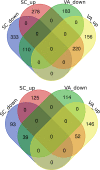Comparative transcriptomics of spotted seatrout (Cynoscion nebulosus) populations to cold and heat stress
- PMID: 33598136
- PMCID: PMC7863673
- DOI: 10.1002/ece3.7138
Comparative transcriptomics of spotted seatrout (Cynoscion nebulosus) populations to cold and heat stress
Abstract
Resilience to climate change depends on a species' adaptive potential and phenotypic plasticity. The latter can enhance survival of individual organisms during short periods of extreme environmental perturbations, allowing genetic adaptation to take place over generations. Along the U.S. East Coast, estuarine-dependent spotted seatrout (Cynoscion nebulosus) populations span a steep temperature gradient that provides an ideal opportunity to explore the molecular basis of phenotypic plasticity. Genetically distinct spotted seatrout sampled from a northern and a southern population were exposed to acute cold and heat stress (5 biological replicates in each treatment and control group), and their transcriptomic responses were compared using RNA-sequencing (RNA-seq). The southern population showed a larger transcriptomic response to acute cold stress, whereas the northern population showed a larger transcriptomic response to acute heat stress compared with their respective population controls. Shared transcripts showing significant differences in expression levels were predominantly enriched in pathways that included metabolism, transcriptional regulation, and immune response. In response to heat stress, only the northern population significantly upregulated genes in the apoptosis pathway, which could suggest greater vulnerability to future heat waves in this population as compared to the southern population. Genes showing population-specific patterns of expression, including hpt, acot, hspa5, and hsc71, are candidates for future studies aiming to monitor intraspecific differences in temperature stress responses in spotted seatrout. Our findings contribute to the current understanding of phenotypic plasticity and provide a basis for predicting the response of a eurythermal fish species to future extreme temperatures.
Keywords: Cynoscion nebulosus; RNA‐seq; climate change; phenotypic plasticity; temperature stress; transcriptome.
© 2020 The Authors. Ecology and Evolution published by John Wiley & Sons Ltd.
Conflict of interest statement
None declared.
Figures



References
Associated data
LinkOut - more resources
Full Text Sources
Miscellaneous

